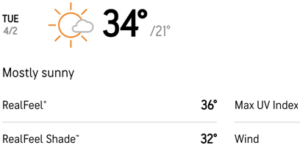By Spandan Pandya, Physics Department, Ashoka University, Haryana, India
Overview of the Problem
Heatwaves are progressively becoming an integral aspect of India’s quotidian reality, presenting a formidable challenge for policymakers. The first step in addressing this looming epidemic is to operationalise heatwaves using a scientific framework. The NDMA defines a heatwave in the following form[1]:
When the normal maximum temperature of a station is less than or equal to 40°C Heat Wave Departure from normal is 5°C to 6°C
When the normal maximum temperature of a station is more than 40°C Heat Wave Departure from normal is 4°C to 5°C
Notice how both these definitions rely heavily on the idea of temperature and Celsius being the sole litmus test of what constitutes a heatwave. Therefore, for many naïve policymakers, temperature control becomes the sole method of combatting heatwaves. The data for heatwaves immediately brings this folly to the foreground. The government data argues that:
“at least 264 people have died across 14 states due to heatwaves this year as of June 30, 2023. Of this, 120 deaths — the highest human causality in the state due to heatwaves since 2015 — or close to 45 percent, were reported from Kerala”[2].
This data does not seem to match the Celsius-oriented policymaker’s thought process, since one barely associates Kerala with scorching heat. Despite this, the data seems to suggest a lot more deaths in a humid but low-temperature environment rather than a high-temperature but dry environment. In reality, what really aggravates heatwave deaths is a correlation between temperature and humidity rather than an absolute temperature scale. This gap indicates the need for a new scale of measurement that is convenient rather than the one accepted in scientific papers.

The Wet Bulb Temperature
A more humane parameter to measure the temperature accurately predicting the presence of a heatwave is the “wet bulb temperature”. A wet-bulb temperature is a simple measurement where a muslin cloth is dipped into water to mimic humid conditions, and then this damp cloth is tied to a mercury thermometer. This “wet bulb temperature” tries to mimic how all human beings interact with heat – by sweating through their pores. Consider the skin on your body, for example, the wet-bulb temperature will show the minimum temperature the skin can reach if it’s a hot day outside and there is sweat evaporating from its surface.
An absolute temperature of 40°C in Gujarat with no humidity will still allow people to sweat naturally. However, even a 36°C temperature in Kerala with a 90% humidity level can stop people from cooling themselves through evaporative losses, leading to increased heatstroke casualties. The highest acceptable wet-bulb temperature for humans is 35°C (95◦F) for six hours. Above that point, even healthy people begin to develop serious, often deadly health problems. This level is crucial because it’s impossible to escape such effects even with unlimited water and shade. If a policy-maker were to look at the temperature readings in Delhi and decide to mist Kerala, areas would become even more humid, worsening the heat wave scenario.

Alternate Realisations
The idea that Celsius needs additional realisations to make it more conducive to measure comfort is being seriously considered even in the space of commercial weather forecasting services and personal health devices. Many algorithms have been devised to come up with Celsius equivalent temperatures which include the effects of shade, clothing, wind, temperature fluctuations, and working hours. All these parameters and models to obtain temperatures are important in our quest to understand heat waves as a real catastrophe that needs to be mitigated.
Conclusion:
Even after sustained heatwaves, the world has not come up with a single definition of what it means to classify heatwaves as a calamity. The definitions that rely on Celsius alone are not enough to implement a thorough policy that applies to geographically and climatically diverse parts of the world. The problem of heatwave is multipronged. In this regard, the Wet Bulb Temperature paves the way for an easy-to-track unit of temperature that takes into consideration not only temperature but also humidity. Setting a standardised wet temperature scale in all weather stations in the country and conducting heat surveys with this unit can save many lives.
[1] NCDC, MoHFW (no date) National Disaster Management Authority, Heat Wave | NDMA, GoI. Available at: https://www.ndma.gov.in/Natural-Hazards/Heat-Wave#:~:text=A%20Heat%20Wave%20is%20a,cases%20even%20extend%20till%20July. (Accessed: 20 June 2024).
[2] Pandey, K. (2023) Data gaps in heatwave deaths widen as India battles record-smashing temperatures, Down To Earth. Available at: https://www.downtoearth.org.in/news/climate-change/data-gaps-in-heatwave-deaths-widen-as-india-battles-record-smashing-temperatures-90839 (Accessed: 20 June 2024).
Disclaimer: The views expressed in this piece are those of the author/s and do not necessarily reflect the views or policies of AIDMI.